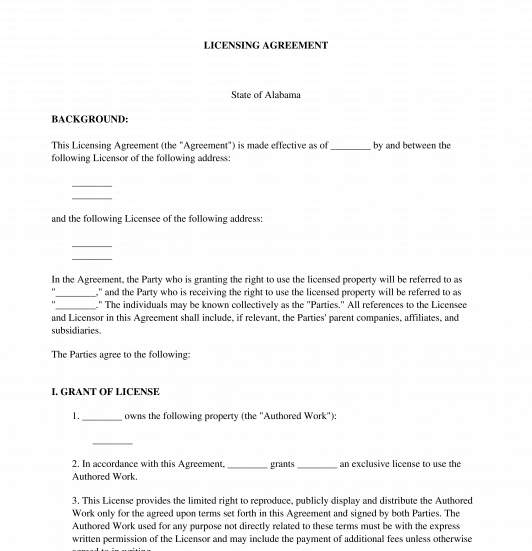 08/31/2025
08/31/2025

Answer a few questions and your document is created automatically.

Your document is ready! You will receive it in Word and PDF formats. You will be able to modify it.




Rating: 4.8 - 357 votes
Download a basic template (FREE) Create a customized documentA licensing agreement is a document used by the owner of some form of intellectual property (IP) — such as a logo, photograph, or song — to give permission to some other individual to use that property. The agreement outlines how the party who owns the property, known as the licensor, will grant the license to use their property to the party who will use the property, known as the licensee. This type of agreement is used in situations where the creator of intellectual property is okay with someone else using their property in specific ways and for limited periods of time, but wishes ultimately to retain their rights to the property and be compensated in exchange for giving the license.
By using a licensing agreement, the owner of intellectual property can make money while also controlling how their property is used and disseminated out in the world. Further, individuals being granted a license can use other people's intellectual property to grow their own business or make a living while protecting themselves from intellectual property infringement claims by defining the terms of the property's use.
Though both documents involve intellectual property, they have different purposes. A licensing agreement is used by the owner of the intellectual property to grant permission to someone else to use that property. There are often limits are how and for how long they may use the property. The property owner is typically compensated in exchange for the license. Even though the property owner grants a license to someone else to use the property, they still maintain total ownership.
An intellectual property release is used when the owner of intellectual property would like to give away all the rights to their work to another party. The owner does not receive continue compensation, called royalty payments, in exchange for transferring the property. Once the intellectual property release is completed, the original intellectual property owner no longer has any rights to use the property.
No, it is not mandatory to use a licensing agreement. An owner of intellectual property may informally tell someone that they are allowed to use that property as they please. However, by not using a licensing agreement, both the property owner and the other party are putting themselves at risk. The person using the property that does not belong to them is in danger of later being sued if the property owner changes their mind. The property owner may also lose control over how their IP is used, potentially damaging its value. Using a licensing agreement provides clear terms and legal protections for both parties.
Royalties are payments made to the licensor by the licensee in exchange for permission to use the IP. These can be one-time fees, fixed dollar amounts per sale of product made using the IP, or a percentage of total sales of the products made by the licensee.
In the context of a licensing agreement, exclusivity means that only the licensee and no other third parties will have a license to use the property. For example, a screen printer who creates a logo may grant an exclusive license to one specific t-shirt company to use the logo, so no other shirt companies can use that same logo.
Before making a licensing agreement, the potential licensee should do due diligence to be sure that the IP being offered is valid and enforceable. This can be done by finding patents, looking up trademark registrations, or identifying copyright verifications.
Once the licensing agreement is complete and has been reviewed by both parties, both the licensor and the licensee should sign and date the contract. The document does not need to be notarized or witnessed to be legally binding. The parties should each save a copy of the licensing agreement in their files for future reference and in case of dispute or disagreement.
A licensing agreement must include at least the following mandatory clauses:
In addition to the above mandatory clauses, the following information may also be included:
There are no laws outlining what must be put into a licensing agreement. Overall, intellectual property in the United States is covered under primarily federal law, with the main applicable statute being the Copyright Act of 1976. It is best practice to include as much detail about the work as possible, in the agreement, so that if a dispute should arise, the rights to the specific work are clear.
You fill out a form. The document is created before your eyes as you respond to the questions.
At the end, you receive it in Word and PDF formats. You can modify it and reuse it.
Guides to help you
Licensing Agreement - FREE - Template - Word & PDF
Country: United States